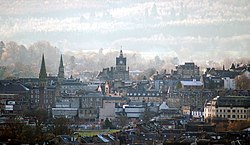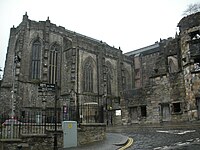Stirling
| Stirling Gaelic: Sruighlea | |
| Stirlingshire | |
|---|---|
 Stirling City Centre | |
| Location | |
| Grid reference: | NS795935 |
| Location: | 56°7’2"N, 3°56’23"W |
| Data | |
| Population: | 33,710 (2008 est) |
| Post town: | Stirling |
| Postcode: | FK7-FK9 |
| Dialling code: | 01786 |
| Local Government | |
| Council: | Stirling |
| Parliamentary constituency: |
Stirling |
Stirling is a city and ancient burgh in Stirlingshire. The city is gathered around a large fortress and mediæval old-town beside the River Forth. Historically Stirling was strategically important as the "Gateway to the Highlands"; It held the lowest bridge over the River Forth flowing eastward and to the west the mountains and ultimately the Clyde bar the way north or south, leaving Stirling standing in a narrow neck of passable land joining the Lowlands to the Highlands.
Stirling itself stands on the south bank of the Forth, which forms Stirlingshire’s northern boundary for all but a few miles.
One of the principal royal strongholds of the mediæval Kingdom of Scotland, Stirling was created a Royal burgh by King David I in 1130. In 2002, as part of Queen Elizabeth II's Golden Jubilee, Stirling was granted city status.
Geography

Stirling is renowned as the Gateway to the Highlands and is generally regarded as occupying a strategic position at the point where the flatter, largely undulating Scottish Lowlands meet the rugged slopes of the Highlands along the Highland Boundary Fault. The starkness of this contrast is evidenced by the many hills and mountains of the lower Highlands such as Ben Vorlich and Ben Ledi which can be seen to the northwest of the city. On the other hand, the Carse of Stirling, stretching to the west and east of the city, is one of the flattest and most agriculturally productive expanses of land in the whole region.
The city itself has grown up around its castle which stands atop an ancient quartz-dolerite sill, a major defensive position which was at the lowest crossing point on the River Forth. Stirling stands on the Forth at the point where the river widens and becomes tidal.
To the east of the city the Ochil Hills dominate the skyline with the highest peak in the range being Ben Cleuch, although Dumyat stands more prominently by Stirling. The Ochils meet the flat carse (floodplain) of the River Forth to the east of the distinctive geographical feature of Abbey Craig, a crag and tail hill upon which stands the 220 foot Wallace Monument.[1]
Top of the Town
Stirling's historic centre is known as the Top of the Town and consists of Broad Street, Castle Wynd, Ballengeich Pass, Lower Castle Hill Road, and St Mary's Walk. These streets all lead up to Stirling Castle and are the favourite haunt of tourists who stop off at the Old Town Gaol, Argyll's Lodgings and the castle. Ballengeich Pass leads to the graveyard at Ballengeich and the Castle Wynd winds past the old graveyard.
The Top of the Town from Broad Street upwards is renowned for its unique cobblestoned roads, and cars can be heard rattling over the cobblestones on the way down. Craft shops and tourist focused shops are evident on the way up and once at the top one is treated to a panoramic view of Stirling, without having to pay to get into the castle.
Name of the town

The origin of the name "Stirling" is uncertain. It appears in the charters of King Davis as "Striuelyn" or "Striuelin". Folk etymology suggests that it originates in either a Scots or Gaelic term meaning the place of strife. Other sources suggest that it originates in a Brythonic (Old Welsh) name meaning "dwelling place of Melyn".[2]
The town's earliest burgh seal, of which an impression of 1296 is on record, bears two Latin inscriptions:[3]
- Hic Armis Brvti Scoti Stant Hic Crvce Tvti (The Britons stand by force of arms, The Scots are by this cross preserved from harm) and
- Continet Hoc in Se Nemvs et Castrvm Strivelinse (The Castle and Wood of Stirling town are in the compass of this seal set down)
History

A Stone Age settlement stood at Stirling. the Randolphfield standing stones remaining a legacy.[4] and Kings Park prehistoric carvings[5] that can still be found south of the town, Stirling has been strategically significant since at least the Roman occupation of Britain, due to its naturally defensible hill (latterly the site of Stirling Castle), and its commanding position at the foot of the Ochil Hills on the border between the Lowlands and Highlands, at the lowest crossing point of the River Forth. Stirling remained the Forth's lowest crossing until the construction of the Kincardine Bridge further downstream in the 1930s.
Some historians have identified Stirling as the Northumbrian frontier fortress of Iudeu or Urbs Giudi where Oswiu of Northumbria was besieged by Penda of Mercia in about 654.[6]

A ford, and later bridge, of the River Forth at Stirling brought wealth and strategic influence, as did its port. The town was chartered as a royal burgh by King David in the 12th century, with charters later reaffirmed by later monarchs (the town then referred to as Strivelyn). Major battles during the Wars of Scottish Independence took place at the Stirling Bridge in 1297 and at the nearby village of Bannockburn in 1314 involving the famed William Wallace and Robert the Bruce respectively. There were also several sieges of Stirling Castle in the conflict.
Standing near the castle, the Church of the Holy Rude is one of the town's most historically important buildings. It was rebuilt in the 15th century after Stirling suffered a catastrophic fire in 1405, and is the only surviving church in the United Kingdom apart from Westminster Abbey, to have held a coronation. On 29 July 1567 the infant son of Mary, Queen of Scots, was crowned James VI of Scotland here. Musket shot marks from Oliver Cromwell's troops during the Wars of the Three Kingdoms are clearly visible on the tower and apse. Another important historical religious site in the area is Cambuskenneth Abbey.
On 12 September 1648, during the War of the Three Kingdoms, the Battle of Stirling was fought in the centre of the town.
The fortifications continued to play a strategic military role during the 18th century Jacobite Rebellions. In 1715, the Earl of Mar failed to take control of the castle. In January 1746, the army of The Young Pretender seized control of the town but failed to take the Castle. On their consequent retreat northwards, his followers blew the church of St Ninians up, where they had been storing munitions; only the tower survived and can be seen to this day.
Economically, the city's port supported overseas trade, including tea trade with India and timber trade with the Baltic. The coming of the railways in 1848 started the decline of the river trade, not least because a railway bridge downstream restricted access for shipping. By the mid 20th century the port had ceased to operate.

References
- ↑ Gazetteer for Scotland Abbey Craig
- ↑ "Pabay (Harris), Pabaigh" (PDF). http://www.scottish.parliament.uk/vli/language/gaelic/pdfs/placenamesP-Z.pdf. Retrieved 2010-07-14.
- ↑ RM Urquhart, Scottish Burgh and County Heraldry, London, 1973
- ↑ "Randolphfield, Stirling, Stirlingshire "The Northern Antiquarian"". Megalithix.wordpress.com. 2010-03-08. http://megalithix.wordpress.com/2010/03/08/randolphfield-stirling/. Retrieved 2010-07-14.
- ↑ "King’s Park, Stirling, Stirlingshire "The Northern Antiquarian"". Megalithix.wordpress.com. 2008-11-25. http://megalithix.wordpress.com/2008/11/25/kings-park-stirling-stirlingshire/. Retrieved 2010-07-14.
- ↑ James E. Fraser: Bede, the Firth of Forth, and the Location of Urbs Iudeu, The Scottish Historical Review, Vol 87, Number 1: No. 223, April 2008
Mair, Craig (1990). Stirling: The Royal Burgh. John Donald Publishers. ISBN 0-85976-420-6.
Outside links
- Stirling Castle (Historic Scotland)
- Mapping the Town: the history of Stirling, presented by Julian Richards (BBC Radio 4) (RealAudio format)
- Photos of Stirling
- Stirling Gaelic Choir
- Tolbooth, Stirling's venue for live music
- Albion Trust Video link shows worlds oldest football, located at Smith Museum Stirling
| Cities in the United Kingdom |
|---|
|
Aberdeen • Armagh • Bangor (Caernarfonshire) • Bangor (County Down) • Bath • Belfast • Birmingham • Bradford • Brighton and Hove • Bristol • Cambridge • Canterbury • Cardiff • Carlisle • Chelmsford • Chester • Chichester • Colchester • Coventry • Derby • Doncaster • Dundee • Dunfermline • Durham • Ely • Edinburgh • Exeter • Glasgow • Gloucester • Hereford • Inverness • Kingston upon Hull • Lancaster • Leeds • Leicester • Lichfield • Lincoln • Lisburn • Liverpool • City of London • Londonderry • Manchester • Milton Keynes • Newcastle upon Tyne • Newport • Newry • Norwich • Nottingham • Oxford • Perth • Peterborough • Plymouth • Portsmouth • Preston • Ripon • Rochester • Salford • Salisbury • Sheffield • Southampton • St Albans • St Asaph • St David's • Southend-on-Sea • Stirling • Stoke-on-Trent • Sunderland • Swansea • Truro • Wakefield • Wells • Westminster • Winchester • Wolverhampton • Worcester • Wrexham • York |